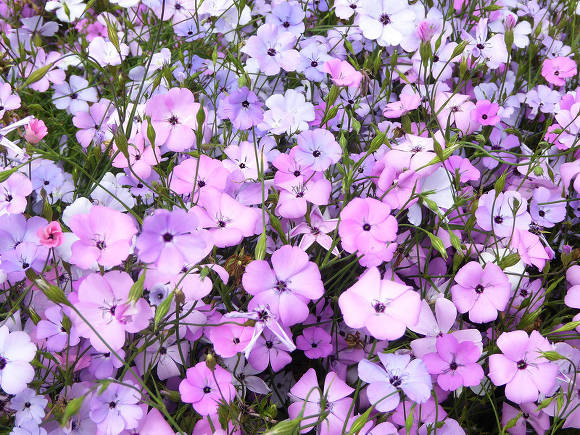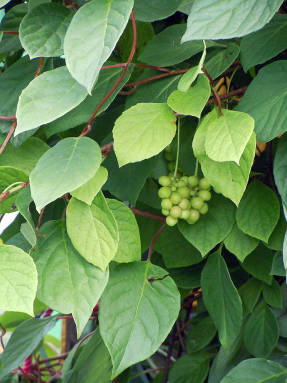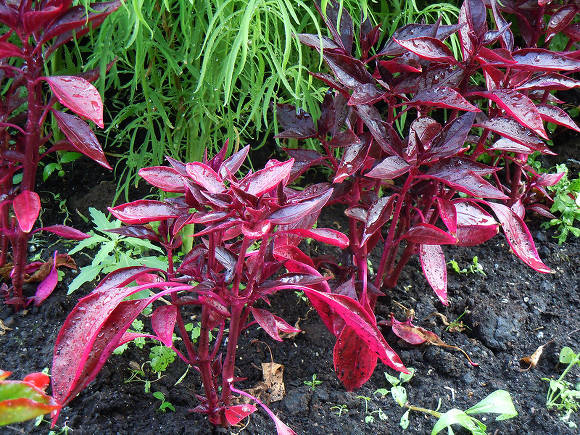Soulmate(Сalamintha) - a small genus of fragrant plants belonging to the lamiplocet family (Lamiaceae). Within the family, the soul mate is close to mint. On the territory of Russia there are 3 types: catnip soul (Сalamintha nepeta), soul maker large-flowered (Сalamintha grandiflora), mint-leaved soulmate, or medicinal (Сalamintha menthifolia).
Foreign botanists now classify all of its representatives as a scent (Clinopodium), including 148 species of lamb, although disputes on the composition of the genus continue.

The catnip soul was first described by Karl Linnaeus in 1753 and referred to as lemon balm. Then he wandered from one clan to another for a long time, having even been a thyme. Now - if you want, call him a soulmate, but if you want - a scent.
The seeds of the catnip are sold here in the category of vegetable spicy-aromatic crops used in cooking. However, this unpretentious and long-flowering plant is also promising as an ornamental one. The name itself Calamintha comes from Greek kalos - beautiful, i.e. means "beautiful mint". Another view is no less attractive - the large-flowered soul maker (Сalamintha grandiflora).
Soulcatcher (Сalamintha nepeta syn. Clinopodium nepeta) on the territory of Russia it grows in forests and among shrubs, on rocky slopes in the Ciscaucasia and in the Caucasus, rising to the middle mountain belt. Distributed throughout southern Europe, North Africa and Western Asia to Iran.
The specific name of the plant is given for its resemblance to the catnip (Nepeta cataria)... And the word itself nepeta, presumably, is the name of the Etruscan city where this plant was grown.
The catnip is a perennial herb 20-50 (80) cm tall, forming lush bushy clumps of a beautiful shape due to short woody rhizomes. All green parts of the plant are softly covered with deflected hairs. Stems are stupidly tetrahedral, lodging, take root upon contact with the ground. The leaves are opposite, on petioles, the structure is very reminiscent of catnip leaves, and even more - oregano. The leaf blades are round-ovate, serrate-toothed along the edge, but they can also be almost entire, densely hairy, grayish-green in the wild type. Flowers are collected on the tops of vertically rising stems and in the axils of the upper leaves in dichasia inflorescences, forming an intermittent one-sided racemose inflorescence, towering above the foliage. The flowers are two-lipped, with a tubular-bell-shaped corolla twice as long as the calyx, up to 12 mm long, which can have any shades from white to lilac with a white throat. Fruits are oblong brown nuts. In nature, the plant blooms from May all summer. In our strip - from June to September.

Large-flowered soul maker(Сalamintha grandiflora syn.Clinopodium grandiflora) in Russia it also grows in the Caucasus and Ciscaucasia in shady forests. In general, it is similar to the previous species, but, confirming its name, it has larger flowers 25-30 mm long, purple in color with a white throat. The leaves are also larger, oblong-ovate, often cordate at the base, coarsely toothed or sharply serrate along the edge. It blooms less abundantly than catnip.
Has a decorative variety Variegata with irregular yellowish specks on the leaves.

Cultivation of a kotovnikov soul mate
The soul mate is a rather unpretentious plant. The key to successful cultivation is well-drained soil and proper watering.
This plant, perennial in nature, is a small annual, like the catnip. But if the catnip is kept in a biennial culture, then the soul mate can persist for 3-4 years.
Location... The soul mate is of Mediterranean origin and this must be taken into account when growing. The place for it is chosen sunny, warmed up, although in the middle of the day a slight shading is possible.It is good if it is protected from the prevailing winds by buildings or shrubs. But it doesn't grow in the shade.
The soil... The soul mate grows well on loose soils (sandy loam is ideal), which will give its stems the opportunity to take root when lodging. The acidity of the soil should be in the range from slightly acidic to alkaline (pH 6.6-8.5). This includes stony soils.
Watering... The plant has the greatest decorative effect at constant moderate humidity, but at the same time it tolerates drought well. This soulmate is convenient for summer residents who leave plants without watering for a week. Waterlogging is unacceptable, especially in winter, because leads to damping off of the plant.
Top dressing... Considering the culinary value of the soul mate, we recommend using organic matter for feeding - pour a little compost with the addition of wood ash around the periphery of the plant. By the end of July, it is useful to feed with potassium monophosphate, which has a positive effect on winter hardiness. If the soil on the site requires deoxidation, then in the fall, do not forget to apply dolomite flour under the plant annually.
In general, the plant is Spartan, it can do on cultivated soils and without top dressing.
Care... In addition to watering and fertilizing, plant care consists in weeding and loosening the soil. The plant gives self-seeding, and if it is not needed, the faded inflorescences are cut off before the seed rains, which occurs at the end of September-October.
Diseases and pests... The soul mate is almost not affected by pests and diseases. The only possible attack is powdery mildew. It is best to deal with it with the help of pharmacy Furacilin - crush 2 tablets into powder, brew with a small amount of boiling water until dissolved, then bring to a volume of 1 liter. Spray the plant.
Harvest... Cutting greens for culinary and medicinal use is carried out at the beginning of flowering, 2-3 times per season. Bunches of grass are harvested dried, hanging down in inflorescences in the attic or in another well-ventilated dark and dry room.
Wintering... The stems are cut for the winter, but not too low. The winter hardiness of the plant is up to -28 degrees (zone 5), so it is useful to slightly cover it with dry litter of large-leaved species - linden, maple, apple trees, provided that it is not sick.
If you wish, you can take a couple of small specimens on the kitchen windowsill at the end of September. The stems are pruned to stimulate the growth of young greenery.
Learn more about indoor growing- in the article Spicy herbs on the windowsill.

Reproduction
The main breeding method of the soul mate is seed, through seedlings. The plant is sown in March to a depth of 0.5-1 cm. At a temperature of + 21 ° C, the seeds germinate for about 2 weeks. In the phase of two true leaves, the seedlings dive into individual pots. They are planted in open ground at the end of May at a distance of 30-40 cm.
Easily propagated by self-rooted stems or layering, as well as green cuttings 10-15 cm long and spring division of rhizomes.
Varieties and their uses
There are no zoned varieties in the State Register of Breeding Achievements of the Russian Federation, but there is a soul mate and a variety on sale.
Soulmaker Blue Beads - compact, up to 30 cm tall, with bluish flowers. Has good winter hardiness. The leaves have a cooling taste and a strong mint-like aroma. Rich in essential oils. It is used fresh and dried as a spicy-aromatic culture - as a seasoning, as a medicinal plant, for tinctures and decoctions.
The leaves make a wonderful tea with a tangy aroma, like flea mint.
 |  |
Medicinal properties
As a medicinal plant, the catnip was widely used in the Middle Ages, but now it has significantly lost its value and remained a home remedy. The herb contains up to 2% essential oil. Its hypoglycemic, sedative, expectorant, diaphoretic and antipyretic effects have been confirmed. Due to its wound-healing properties, the soulmate helps well with stomach diseases.Used to treat insomnia, depression, painful periods.
Contraindications: The soul mate is contraindicated in pregnant women, because may cause miscarriage.
Decorative use
The soul mate is a beautiful plant with softly pubescent foliage and loose clusters of small flowers. We can say that it is a perennial of continuous flowering, decorative from spring to autumn. It will perfectly decorate a rocky hill, retaining wall. Fragrant borders are formed from it, and if they are located along the path, you will certainly feel the aroma of the plant at every contact with it. It is good to plant this plant near the house and resting places - near benches and gazebos, as well as under the windows of a house, veranda, terrace.
Cool shades of leaves and flowers are always desirable in a mixborder or fragrant garden. This is a wonderful addition to the design of an ornamental garden, convenient in that it does not spread much, while maintaining sufficient compactness. The soul mate is fond of bees and other pollinators that are so necessary in the garden.

Good drought resistance allows you to grow a soul mate in flowerpots and containers. In mono-planting, it forms a neat hemisphere, and gives the compositions of flowering plants a little Mediterranean flavor.
And further. This plant is useful to plant next to crops susceptible to fungal diseases, because its essential oil has fungicidal properties.







